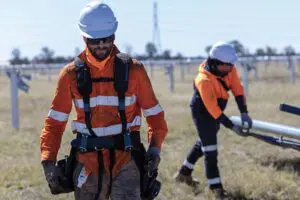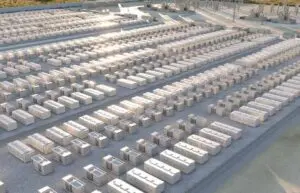A New South Wales government inquiry into undergrounding the transmission lines for HumeLink has ruled that the current overhead option is the “correct approach,” as Transgrid moves the controversial project to the next stage of the approvals process.
The results of the inquiry – released a day after the Wednesday publication of a 957-page Environmental Impact Statement for HumeLink – have been slammed as a “complete sham” by community groups opposing the transmission build.
A statement from a group called Stop Rethink Humelink said on Thursday that Transgrid had shown “complete disregard to due process” by buying equipment and choosing a preferred supplier for the transmission project before the findings of the inquiry were revealed.
The claim refers to Transgrid’s announcement in July that it had struck a deal with China’s ZTT International for the delivery of more than 17,500 kilometres of high-voltage conductors to get ahead on HumeLink and VNI West.
“By securing supply now, we can deliver projects faster and cheaper,” said Transgrid’s Craig Stallan at the time.
“It’s also reducing risk as we compete with other energy companies and nations to secure critical, large-scale equipment, materials and skilled labour to deliver the projects Australia needs.”
Stop Rethink HumeLink says the timing of the EIS also suggests Transgrid knew the outcome of the state government inquiry before it was announced. The group has promised to double down on its fight against the project.
HumeLink is one of the largest energy infrastructure projects proposed for New South Wales, with plans for 360km of new transmission lines, and new or upgraded infrastructure at three locations.
The 500-kilovolt connection will link Wagga Wagga, Bannaby and Maragle. It’s particularly important to connect the 2.2GW Snowy 2.0 hydro project to to Sydney, Newcastle and Wollongong, where more renewable power is most needed.
It is also highly contentious, drawing criticism from farmers, local communities and green groups over its potential impacts on locals – visual, financial and fire safety – and on the environment it cuts through, including on the Kosciusko National Park.
In the face of this public push-back, an inquiry was set up in July to look into the possibility of changing the construction of the overhead lines to underground.
But the project is also controversial for its costs, which have already blown out from early estimates of $1.3bn to $3.3bn – a cost that will ultimately be born by NSW electricity consumers.
A previous study by Transgrid estimated the cost of undergrounding HumeLink at $11.5 billion – at least three times more than the project’s estimated overground cost of $3.3 billion. The study also claimed the underground link would take seven years to build, compared to four to five years for the overhead option.
Transgrid’s findings were “not endorsed” by the Humelink Community Consultation Groups Steering Committee, which was formed by Transgrid and made up of local community members.
In a response to the study they said the approach was unbalanced and undertaken through a lens that “favours an approach of focusing on the negative aspects of selecting underground high voltage cables over AC overhead lines.”
In June, the NSW Labor state government commissioned inquiry led by the Legislative Council’s Standing Committee on State Development in a bid to put the issue to bed, one way or the other, and move the “state critical” project along.
Its findings this week more or less fall in line with the final conclusions of Transgrid – undergrounding is not an economically justifiable option.
“We acknowledge that this is not what many in the local community are calling for, and we emphasise that this was not an easy conclusion to come to,” said committee chair Emily Suvaal in a forward to the inquiry report.
“However, the evidence before us was clear that undergrounding would result in substantial additional cost and lengthy delays and would be unlikely to receive regulatory approval.”
The critics, meanwhile, remain unconvinced.
“This entire exercise was pre-determined and a complete sham,” said community spokesman for Stop Rethink Humelink, Michael Katz. “It was window dressing to hide what has become process dictated by politics.
“For the community, this battle is far from over and may cause significant delays.
“We will also continue to release information that proves our case in the hope that the government will one day listen to reason rather than vested interests.”
In its EIS, Transgrid says HumeLink will deliver “a cheaper, more reliable and more sustainable grid and help to transition Australia to a low carbon future.
“This would be achieved by increasing the amount of renewable energy that could be delivered within the
National Electricity Market, including by supporting the transfer of energy from existing and new renewable energy projects in the region.”
It says the project has been designed to avoid and minimise impacts, and to respond to the issues raised by the community and stakeholders.
Those “residual impacts” unable to be avoided, the EIS says, are considered manageable – and if not manageable, then able to be offset.
“On balance, the strategic need and benefits of the project outweigh the mitigated project impacts,” the report says. “Therefore, the project is justified and would be in the public interest.”
HumeLink project director Jeremy Roberts says the EIS is a “major step in the planning process,” while also providing further opportunity to respond on significant issues like biodiversity, bushfire risk and visual amenity.
“I encourage all stakeholders to provide their submissions to the NSW Department of Planning and Environment,” he said.
Roberts says the EIS includes 19 specialist studies and assessments across areas such as the environment, biodiversity, bushfire risk and visual amenity. It also includes strategies to mitigate potential impacts from the project during construction and operation.
The environmental impact statement is currently open for submissions, community members are able to respond to the proposal until the 26th of September.










